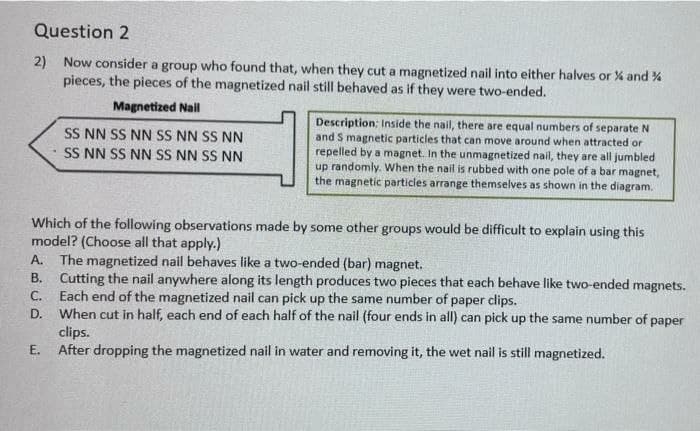Question 2 2) Now consider a group who found that, when they cut a magnetized nail into either halves or % and % pieces, the pieces of the magnetized nail still behaved as if they were two-ended. Magnetized Nal SS NN SS NN SS NN SS NN SS NN SS NN SS NN SS NN Description: Inside the nail, there are equal numbers of separate N and S magnetic particles that can move around when attracted or repelled by a magnet. In the unmagnetized nail, they are all jumbled up randomly. When the nail is rubbed with one pole of a bar magnet, the magnetic particles arrange themselves as shown in the diagram. Which of the following observations made by some other groups would be difficult to explain using this model? (Choose all that apply.) A. The magnetized nail behaves like a two-ended (bar) magnet. B. Cutting the nail anywhere along its length produces two pieces that each behave like two-ended magnets. Each end of the magnetized nail can pick up the same number of paper clips. D. When cut in half, each end of each half of the nail (four ends in all) can pick up the same number of paper clips. After dropping the magnetized nail in water and removing it, the wet nail is still magnetized. С. E.
Question 2 2) Now consider a group who found that, when they cut a magnetized nail into either halves or % and % pieces, the pieces of the magnetized nail still behaved as if they were two-ended. Magnetized Nal SS NN SS NN SS NN SS NN SS NN SS NN SS NN SS NN Description: Inside the nail, there are equal numbers of separate N and S magnetic particles that can move around when attracted or repelled by a magnet. In the unmagnetized nail, they are all jumbled up randomly. When the nail is rubbed with one pole of a bar magnet, the magnetic particles arrange themselves as shown in the diagram. Which of the following observations made by some other groups would be difficult to explain using this model? (Choose all that apply.) A. The magnetized nail behaves like a two-ended (bar) magnet. B. Cutting the nail anywhere along its length produces two pieces that each behave like two-ended magnets. Each end of the magnetized nail can pick up the same number of paper clips. D. When cut in half, each end of each half of the nail (four ends in all) can pick up the same number of paper clips. After dropping the magnetized nail in water and removing it, the wet nail is still magnetized. С. E.
Related questions
Question
I need detailed ans of this objective question

Transcribed Image Text:Question 2
2) Now consider a group who found that, when they cut a magnetized nail into either halves or % and %
pieces, the pieces of the magnetized nail still behaved as if they were two-ended.
Magnetized Nail
SS NN SS NN SS NN SS NN
SS NN SS NN SS NN SS NN
Description; Inside the nail, there are equal numbers of separate N
and S magnetic particles that can move around when attracted or
repelled by a magnet. In the unmagnetized nail, they are all jumbled
up randomly. When the nail is rubbed with one pole of a bar magnet,
the magnetic particles arrange themselves as shown in the diagram.
Which of the following observations made by some other groups would be difficult to explain using this
model? (Choose all that apply.)
A. The magnetized nail behaves like a two-ended (bar) magnet.
Cutting the nail anywhere along its length produces two pieces that each behave like two-ended magnets.
Each end of the magnetized nail can pick up the same number of paper clips.
D. When cut in half, each end of each half of the nail (four ends in all) can pick up the same number of paper
В.
С.
clips.
After dropping the magnetized nail in water and removing it, the wet nail is still magnetized.
Е.
Expert Solution
This question has been solved!
Explore an expertly crafted, step-by-step solution for a thorough understanding of key concepts.
This is a popular solution!
Trending now
This is a popular solution!
Step by step
Solved in 2 steps
